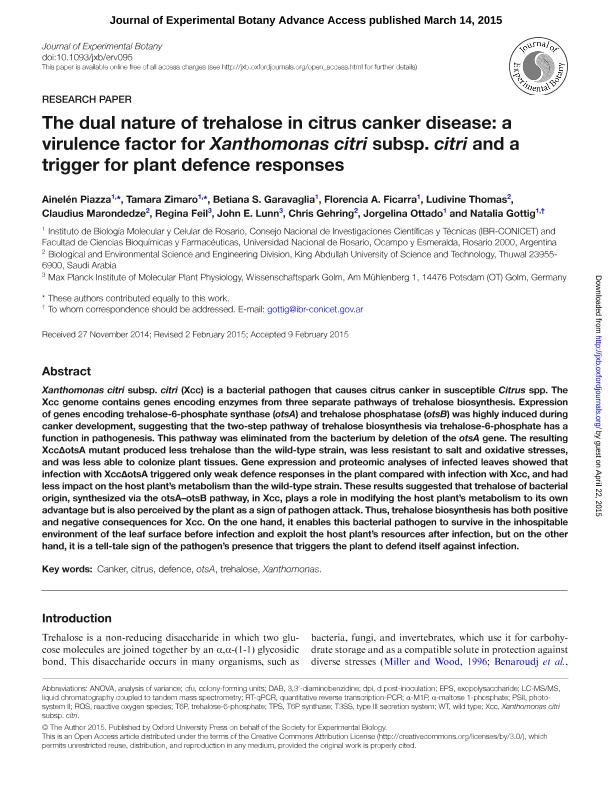Mostrar el registro sencillo del ítem
dc.contributor.author
Piazza, Ainelén Melanie

dc.contributor.author
Zimaro, Tamara

dc.contributor.author
Garavaglia, Betiana Soledad

dc.contributor.author
Ficarra, Florencia Andrea

dc.contributor.author
Thomas, Ludivine
dc.contributor.author
Marondedze, Claudius
dc.contributor.author
Feil, Regina
dc.contributor.author
Lunn, John E.
dc.contributor.author
Gehring, Chris
dc.contributor.author
Ottado, Jorgelina

dc.contributor.author
Gottig Schor, Natalia

dc.date.available
2018-06-28T19:58:46Z
dc.date.issued
2015-05
dc.identifier.citation
Piazza, Ainelén Melanie; Zimaro, Tamara; Garavaglia, Betiana Soledad; Ficarra, Florencia Andrea; Thomas, Ludivine; et al.; The dual nature of trehalose in citrus canker disease: A virulence factor for Xanthomonas citri subsp. citri and a trigger for plant defence responses; Oxford University Press; Journal of Experimental Botany; 66; 9; 5-2015; 2795-2811
dc.identifier.issn
0022-0957
dc.identifier.uri
http://hdl.handle.net/11336/50487
dc.description.abstract
Xanthomonas citri subsp. citri (Xcc) is a bacterial pathogen that causes citrus canker in susceptible Citrus spp. The Xcc genome contains genes encoding enzymes from three separate pathways of trehalose biosynthesis. Expression of genes encoding trehalose-6-phosphate synthase (otsA) and trehalose phosphatase (otsB) was highly induced during canker development, suggesting that the two-step pathway of trehalose biosynthesis via trehalose-6-phosphate has a function in pathogenesis. This pathway was eliminated from the bacterium by deletion of the otsA gene. The resulting XccΔotsA mutant produced less trehalose than the wild-type strain, was less resistant to salt and oxidative stresses, and was less able to colonize plant tissues. Gene expression and proteomic analyses of infected leaves showed that infection with XccΔotsA triggered only weak defence responses in the plant compared with infection with Xcc, and had less impact on the host plant's metabolism than the wild-type strain. These results suggested that trehalose of bacterial origin, synthesized via the otsA-otsB pathway, in Xcc, plays a role in modifying the host plant's metabolism to its own advantage but is also perceived by the plant as a sign of pathogen attack. Thus, trehalose biosynthesis has both positive and negative consequences for Xcc. On the one hand, it enables this bacterial pathogen to survive in the inhospitable environment of the leaf surface before infection and exploit the host plant's resources after infection, but on the other hand, it is a tell-tale sign of the pathogen's presence that triggers the plant to defend itself against infection.
dc.format
application/pdf
dc.language.iso
eng
dc.publisher
Oxford University Press

dc.rights
info:eu-repo/semantics/openAccess
dc.rights.uri
https://creativecommons.org/licenses/by/2.5/ar/
dc.subject
Canker
dc.subject
Citrus
dc.subject
Defence
dc.subject
Otsa
dc.subject
Trehalose
dc.subject
Xanthomonas
dc.subject.classification
Otras Ciencias Biológicas

dc.subject.classification
Ciencias Biológicas

dc.subject.classification
CIENCIAS NATURALES Y EXACTAS

dc.title
The dual nature of trehalose in citrus canker disease: A virulence factor for Xanthomonas citri subsp. citri and a trigger for plant defence responses
dc.type
info:eu-repo/semantics/article
dc.type
info:ar-repo/semantics/artículo
dc.type
info:eu-repo/semantics/publishedVersion
dc.date.updated
2018-06-25T12:37:58Z
dc.identifier.eissn
1460-2431
dc.journal.volume
66
dc.journal.number
9
dc.journal.pagination
2795-2811
dc.journal.pais
Reino Unido

dc.journal.ciudad
Oxford
dc.description.fil
Fil: Piazza, Ainelén Melanie. Consejo Nacional de Investigaciones Científicas y Técnicas. Centro Científico Tecnológico Conicet - Rosario. Instituto de Biología Molecular y Celular de Rosario. Universidad Nacional de Rosario. Facultad de Ciencias Bioquímicas y Farmacéuticas. Instituto de Biología Molecular y Celular de Rosario; Argentina
dc.description.fil
Fil: Zimaro, Tamara. Consejo Nacional de Investigaciones Científicas y Técnicas. Centro Científico Tecnológico Conicet - Rosario. Instituto de Biología Molecular y Celular de Rosario. Universidad Nacional de Rosario. Facultad de Ciencias Bioquímicas y Farmacéuticas. Instituto de Biología Molecular y Celular de Rosario; Argentina
dc.description.fil
Fil: Garavaglia, Betiana Soledad. Consejo Nacional de Investigaciones Científicas y Técnicas. Centro Científico Tecnológico Conicet - Rosario. Instituto de Biología Molecular y Celular de Rosario. Universidad Nacional de Rosario. Facultad de Ciencias Bioquímicas y Farmacéuticas. Instituto de Biología Molecular y Celular de Rosario; Argentina
dc.description.fil
Fil: Ficarra, Florencia Andrea. Consejo Nacional de Investigaciones Científicas y Técnicas. Centro Científico Tecnológico Conicet - Rosario. Instituto de Biología Molecular y Celular de Rosario. Universidad Nacional de Rosario. Facultad de Ciencias Bioquímicas y Farmacéuticas. Instituto de Biología Molecular y Celular de Rosario; Argentina
dc.description.fil
Fil: Thomas, Ludivine. King Abdullah University of Science and Technology; Arabia Saudita
dc.description.fil
Fil: Marondedze, Claudius. King Abdullah University of Science and Technology; Arabia Saudita
dc.description.fil
Fil: Feil, Regina. Max Planck Institute of Molecular Plant Physiology; Alemania
dc.description.fil
Fil: Lunn, John E.. Max Planck Institute of Molecular Plant Physiology; Alemania
dc.description.fil
Fil: Gehring, Chris. King Abdullah University of Science and Technology; Arabia Saudita
dc.description.fil
Fil: Ottado, Jorgelina. Consejo Nacional de Investigaciones Científicas y Técnicas. Centro Científico Tecnológico Conicet - Rosario. Instituto de Biología Molecular y Celular de Rosario. Universidad Nacional de Rosario. Facultad de Ciencias Bioquímicas y Farmacéuticas. Instituto de Biología Molecular y Celular de Rosario; Argentina
dc.description.fil
Fil: Gottig Schor, Natalia. Consejo Nacional de Investigaciones Científicas y Técnicas. Centro Científico Tecnológico Conicet - Rosario. Instituto de Biología Molecular y Celular de Rosario. Universidad Nacional de Rosario. Facultad de Ciencias Bioquímicas y Farmacéuticas. Instituto de Biología Molecular y Celular de Rosario; Argentina
dc.journal.title
Journal of Experimental Botany

dc.relation.alternativeid
info:eu-repo/semantics/altIdentifier/url/http://jxb.oxfordjournals.org/content/early/2015/03/13/jxb.erv095.full.pdf+html
dc.relation.alternativeid
info:eu-repo/semantics/altIdentifier/doi/http://dx.doi.org/10.1093/jxb/erv095
Archivos asociados
